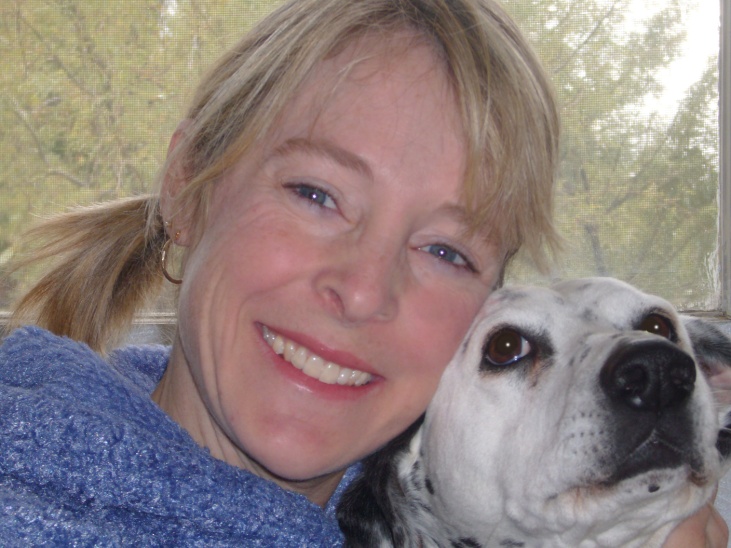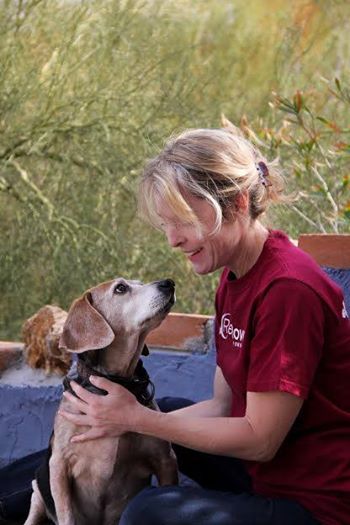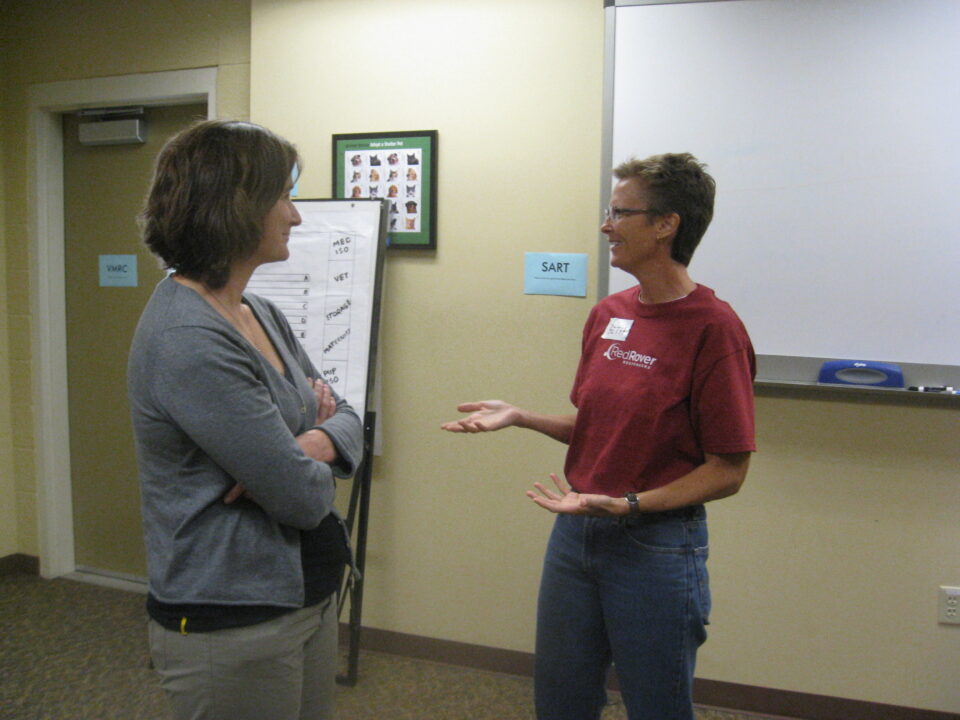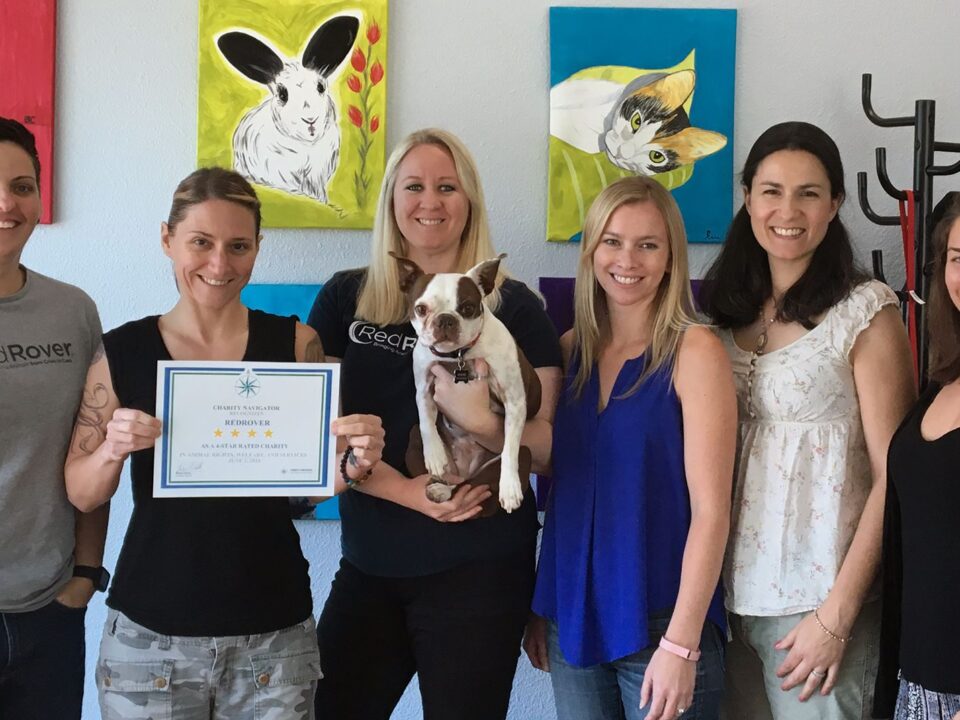A genuine desire to make a difference can make all the difference for animals in crisis
March 14th, 2014
 RedRover is able to bring animals out of crisis and into care through our network of RedRover Responders volunteers available on a moment’s notice to deploy. One of those volunteers is Paula Redinger who first deployed with us in 2003 to help the animal victims of the Southern California fires. Since then, she has become one of our volunteer Communications Assistants, specializing in photography of the animals and our volunteers who care for them. We interviewed her about her experience volunteering for RedRover.
RedRover is able to bring animals out of crisis and into care through our network of RedRover Responders volunteers available on a moment’s notice to deploy. One of those volunteers is Paula Redinger who first deployed with us in 2003 to help the animal victims of the Southern California fires. Since then, she has become one of our volunteer Communications Assistants, specializing in photography of the animals and our volunteers who care for them. We interviewed her about her experience volunteering for RedRover.
Please describe your first experience on a deployment as it relates to the animals and people you helped.
I think my very first deployment was the Southern California wildfires in 2003. There was a Red Cross Shelter for evacuees at a closed air force base and we sheltered the evacuee’s pets right next door. I remember thinking that was a lovely arrangement; that the people in the shelter had a safe place to keep their pets right on-site. When I look back, I think I worked harder at that deployment than any other. We had, what seemed like, hundreds of dogs to walk each day. By the time we finished walking the last dog, it was time to turn around and start walking the first one again. Yet we were happy to do it, and happy to play a role in helping the animals and the community. But, wow! My feet were tired! At the end of the day a cold shower (the hot water was long gone by the time we were done!), and falling asleep on the little Red Cross cots felt like paradise!
What specifically made you decide to become a RedRover Responders volunteer?
I remember seeing a news bit about the organization’s response for the Rodeo Fire in Arizona in 2002, and immediately thought, “THAT is for me!” I’ve always had a love of animals, and a desire to work with them. The Rodeo fire was enormous and something I became emotionally, if not physically, involved in. I experienced Hurricane Andrew in Miami first-hand in 1991, which was a Category 5 storm and, at the time, the costliest disaster to ever hit the US. I had it much easier than many people (no roof came down on my head, although there was a stretch when that felt imminently possible!), but its effect on me was still profound. A friend and I tried to volunteer to help after the storm. It felt disorganized and futile, and the relief efforts, deemed ineffective and uncoordinated by many, were very controversial. I that experience played a role for me, too. Animals seem to be such a vulnerable population; they have no voice of their own, and are powerless to improve their lot. And, helping animals helps the people who love them, too, and not just in all the obvious ways. I remember learning during the Volunteer Training Workshop that the primary reason people return to evacuated areas (putting both themselves and rescue personnel at great risk), is to retrieve animals. Volunteering was certainly an easy way to “give back” using a specific skill I had as a Certified Veterinary Technician. So when the opportunity arose later that same year, I took the Volunteer Training Workshop in Flagstaff, Arizona.
Were you already working as a vet technician when you started volunteering to help animals, or did you volunteer prior to starting that career path? What made you want to work with animals in the first place?
I started working at a veterinary hospital in Tucson in 1996 and passed the required State and National Board Exams to become a Certified Veterinary Technician in 1999. However, my interest in veterinary work goes way back to when I was young, when I was that stereotypical little girl who wanted to be a “doggy doctor.” I guess I never grew out of it! But there’s more to it than that. I love the science of it, of course, but anyone who works in the field has a love of animals, and a reverence of the human-animal connection that runs a just a little deeper. As I got older, it was always a toss up between being a veterinarian and being a flutist. When I went to college, I studied both music and pre-med/vet. It was a tough choice, but in the end, I felt I couldn’t go through life without having given the music path a genuine effort. I’m lucky enough to be eking out a living as a flutist now, and stopped working as a CVT in 2001 because it took too much of a toll on my flute playing. Keeping music skills at a professional level is a time consuming occupation! I do keep my vet tech certification up to date, though. I miss the daily work with animals, so I cherish the opportunity RedRover gives me to stay involved.
 What made you decide to start volunteering with RedRover as a Communications Assistant?
What made you decide to start volunteering with RedRover as a Communications Assistant?
I’m perfectly happy to do whatever RedRover needs me to do, whether it is walking dogs, cleaning cat boxes, assisting veterinarians or taking photographs! I fell into the Communications Assistant work, really. I met current Red Rover Emergency Services Manager Beth Gammie when she was a fellow volunteer at the Apache County, Arizona Hoarding Seizure response. I had blocked off that time for a motorcycle trip to Big Bend National Park, but was called for the response, so decided to point my bike in a different direction and ride to St. Johns, Arizona, instead. Beth was a former rider, so we immediately had two things in common: our love of animals and our love of motorcycles! I have a silly little motorcycle blog (“Eating on Two Wheels” if you must know!), and Beth, who had since become the RedRover Emergency Services Manager, liked my photos enough to invite me to be Communications Assistant for the Pine Ridge Indian Reservation Dog Relocation deployment this past July. I still haven’t made it to Big Bend National Park, but I have no regrets!
Describe some of the challenges and rewards you’ve experienced working in this capacity at a deployment. What do you do to try to communicate the bond that develops between people, our volunteers and the animals we help?
There are, of course, the technical challenges that come with operating any sort of equipment in the field. There’s always some unexpected twist you need to work around to get an internet connection, to power up a failing laptop battery, to move data, not to mention the specific challenges of photography – the subject you’re shooting never does seem to be in the right lighting, the puppy is just a little too wiggly, that sort of thing. Plus the “being at the right place at the right time” game – it never fails that when I’m photographing something on one side of the shelter, 50 yards away, I’m missing the very thing I’ve wanted to photograph all day! While my blog features mostly landscape and food photography, taking good photos of things that move can be hard! I don’t actually own a camera suitable for this, but I’m lucky enough to be able to borrow one, and I do have to spend some time before each deployment reminding myself how to drive it. By the time I’m on site, there’s no time to think about learning a new device. Different deployments pose different challenges, too. One recent deployment this past year offered very little opportunity to capture volunteers interacting directly with the animals, so I had to focus on other aspects of their work. These efforts are just as important for the welfare of the animals, but it’s tough to turn them into that warm and fuzzy photograph you’re hoping for. As long as I’m telling the true story of the deployment, though, that’s fine by me. But these challenges are exactly what make the work fun. When I get something I like after all that effort, it’s very satisfying! As someone who doesn’t do this for a career, it’s pretty exciting to open the end-of-the-year volunteer thank you letter from RedRover, and see my own photograph on the refrigerator magnet! In the end, the credit really goes to the loving work of the volunteers. I just happen to be the lucky one documenting it. With this kind of subject matter, it’s hard to go wrong. Really, it’s quite an honor for me to be asked to do this sort of work, and I’m very touched that RedRover has been happy with what I’ve come up with so far.
You worked as a volunteer for RedRover during the Hurricane Katrina disaster in 2005. Tell us about that experience.
For the Katrina deployment, I worked as an assistant to the veterinarian on site, so much of my own experience and memories of that response revolve around those particular tasks. We would make rounds twice each day. There were so many pets, it took through lunch and beyond to finish morning rounds. My most prominent memories of that deployment are of the volunteers doing their best to make the animals comfortable. Of course we supplied their basic needs of food, water, medical care and anything else they might need, but it’s in the little things they did that I remember most. I remember the shelter area was so hot and dusty that it really affected many of the animals’ eyes. We rinsed hundreds of eyes with saline solution to relieve their discomfort. If I were shooting photos and videos of this deployment, I would want to convey how these volunteers do the little things, the small vignettes that happen within the big picture. I’d also like to show the flexibility and good humor that it takes to work in the field. Many volunteers were sleeping in tents on site because hotel rooms were needed by the displaced victims of the storm.
I remember chuckling at the bizarre military MRE’s we ate (yuck!) and using my camping headlamp as the sole veterinary exam light. Again, these were the little things that humanize the larger event. Undoubtedly the most powerful moment in any natural disaster deployment is the reunion of pet and owner. After all the turmoil of an evacuation, the loss of property, and in the most tragic cases, the loss of loved ones, that single moment of reconnection with a beloved pet is an emotional event beyond description, and something I hope one day to be able to convey with my camera.
Why do you think it’s important to have a Communications Assistant on our deployments?
The Communication Assistant provides a number of important services. Our supporters deserve a clear picture of what our organization does, and the Communications Assistant plays an obvious role in that. I think the media work does a lot for the volunteer base as well. It helps volunteers re-connect with their past deployment experiences and with those deployments they are not personally involved in. It feels great to volunteer, and anything that can recall these feelings keeps the volunteers’ energy and motivation fresh. Of course, it is also a very big piece of the puzzle to constantly expand both our volunteer and financial support base, without which we would have no organization at all. As that expands, so too does our ability to fulfill our mission of “bringing animals from crisis to care.”
What technical/emotional skills do you find are critical to the role of someone volunteering as a Communications Assistant?
It goes without saying that a Communications Assistant volunteer has to have a certain level of photography and computer skills. Photo editing can’t be overlooked, especially when you’re shooting in less than ideal conditions, which are, pretty much, always. In regards to these skills, it’s crucial to be able to solve technical problems in the field, to find more efficient ways of performing time-consuming digital tasks and to be prepared to change your workflow, since something unexpected will always seem to happen. A Communications Assistant needs to be quick, too, and not just with the shutter button. You need to be able to sort through hundreds of photos, find the suitable few, edit them, and get them uploaded for approval while photographable events are happening all around you. In addition, there is a more intangible set of skills – these are the emotional ones – that can be as necessary as the technical set. You need to have a good feeling for what that “1,000 word shot” will be, and not just the luck, but the instincts, to get yourself at the right place at the right time. I’d guess this is really what separates the very best photojournalists from the average. (Let’s make it clear I’m not claiming to be a photojournalist at all – in real life I’m a professional flutist!) At the same time, and this is where some animal behavior knowledge and general sensitivity is key, you need to be able to capture your images without changing the story. I don’t own powerful telephoto lenses, so I’m usually pretty close to the action when I’m taking photographs. I need to be aware that even the little click of the camera shutter, if noticed by an animal (or person!), can drastically change the nature of a photograph. Basic veterinary knowledge helps me identify what is happening during any given exam or procedure, what to expect, when it’s okay to take photos or when it would interfere, and I try to be respectful of this.
What would you say makes RedRover different from the other animal organizations as it relates to the volunteers?
I haven’t volunteered with any other animal organization, so I can’t compare direct experiences. But RedRover is becoming more highly regarded in their field with every deployment. The volunteers I’ve worked with have been well trained, well prepared and very professional, not just in their animal care, but in their overall sensitivity regarding any given response. They conduct post-deployment interviews with the volunteers, which make it clear that RedRover strives to constantly do more, do better, and I like that. I also want to take this opportunity to give great credit to Beth (RedRover Emergency Services Manager), with whom I’ve worked with on a number of deployments. She’s got a rare combination of people skills and animal skills that make things happen, and they happen in a positive manner. She never stops amazing me.
What has been your most rewarding experience with RedRover and helping the animals?
I find that playing any role in the renunciation of pets and their owners is not just gratifying, but genuinely humbling. I’ve found that to be true in my work at the pet hospital, too, even though the actual circumstances have been different. There’s just nothing else like it to bring a lump to your throat! But it’s all rewarding, really. I’m sure I speak for all the volunteers when saying that any task we do, small or great, that helps animals and people, is rewarding. As far as a specific incident that has been rewarding, I think back to my very first deployment. Because of my experience as a CVT, I was asked to periodically do a “walk through” of the shelter, checking in on the health of the animals. I walked by a Dalmatian who had chewed up his blanket, and was standing in a funny hunched posture. To anyone that has worked in the veterinary field, that is a pretty loud signal for “I ate my blankie, and now my tummy hurts,” (otherwise known as abdominal obstruction, which often requires surgery). I was grateful that I could recognize this, and was able to discuss the situation directly with the pet owners. The dog received the necessary veterinary care (there was a mobile vet on site, as I recall), and what could have been a very sad ending was averted.



